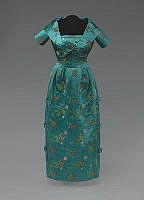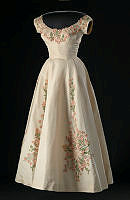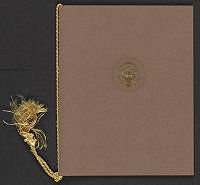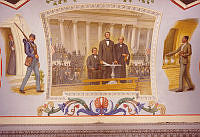Rubenstein Center Scholarship
The Enslaved Households of President James Monroe
This article is part of the Slavery in the President’s Neighborhood initiative. Explore the Timeline
Considered the last “Founding Father” president, James Monroe was born in 1758 into an affluent, slave owning family in Westmoreland County, Virginia. His parents, Spence and Elizabeth Monroe, had aspirations for their eldest son, sending him to Campbelltown Academy. James’ childhood changed dramatically when both of his parents passed away within a span of two years. In 1774, he inherited land and enslaved people from the estate of his father.1 This turn of events compelled James to look after his siblings until his uncle, Joseph Jones, became a paternal surrogate for the Monroe children. Jones encouraged Monroe to attend the College of William & Mary, which he did until he enlisted in the Continental Army’s Third Virginia Infantry Regiment.2

A view of Highland, James Monroe's plantation and primary private residence from 1799 to 1823.
Wikimedia CommonsIn terms of military, political, administrative, and diplomatic experience, James Monroe was one of the most qualified individuals to ascend to the presidency during the nineteenth century. He fought in the American Revolution and was wounded at the Battle of Trenton; served in the legislative bodies of the Virginia General Assembly and the United States Senate, as well as Governor of Virginia; held diplomatic posts across Europe for different administrations; and served as Secretary of State and Secretary of War (briefly acting in both capacities) during the James Madison administration. He also studied law with Thomas Jefferson—and the two men became close friends. In fact, because of his relationship with Jefferson, Monroe purchased land adjacent to Monticello in Albemarle County. This plantation was named Highland and the Monroes—along with a growing enslaved community—lived here from 1799 to 1823.3 That same year, Monroe was elected governor, and during his tenure he and other Virginia slave owners experienced one of the largest attempted insurrections in United States history. Click here to learn more about the enslaved households of President James Madison. Click here to learn more about the enslaved households of President Thomas Jefferson.
On August 30, 1800, Governor Monroe received alarming news that a slave rebellion was forming in the countryside just outside the capital of Richmond. Gabriel, an enslaved blacksmith who lived on Thomas Prosser’s plantation in Henrico County, had organized and inspired about 150 others to take up arms against their enslavers. Two co-conspirators, Pharoah and Tom, confessed the plot to their owner Mosby Sheppard, who then alerted the governor. Monroe ordered up the militia to patrol the city and safeguard the caches of arms and ammunition. A torrential downpour delayed the start of the insurrection, and as word spread about the patrols, Gabriel’s followers fled or went into hiding. Over the course of the next two days, Virginia militiamen terrorized hundreds of enslaved people in and around Richmond by breaking into the quarters and cabins of anyone suspected of conspiring with Gabriel. Most were innocent and only dealt with having their homes invaded and searched—but more than seventy others were arrested and charged.4

On August 30, 1800, Mosby Sheppard wrote this letter to Virginia Governor James Monroe, warning him that enslaved individuals were planning an uprising outside of Richmond.
Library of VirginiaOn September 12, five enslaved men—Will, John, Isaac, Michael, and Ned—were executed in Richmond for their roles in the attempted rebellion. Three days later, another five men—Solomon, Billy, Martin, Charles, and Frank—were also executed. As this second group was heading to the gallows, Monroe sought Vice President Jefferson’s advice on the severity of these punishments:
Where to arrest the hand of the Executioner, is a question of great importance. It is hardly to be presumed, a rebel who avows it was his intention to assassinate his master &ca if pardoned will ever become a useful servant. and we have no power to transport him abroad—Nor is it less difficult to say whether mercy or severity is the better policy in this case, tho’ where there is cause for doubt it is best to incline to the former council.5
Writing from Monticello, Jefferson observed that “there is a strong sentiment that there has been hanging enough. the other states & the world at large will for ever condemn us if we indulge a principle of revenge, or go one step beyond absolute necessity.”6 In the end, seventy-two enslaved men were prosecuted, twenty-six of whom were convicted and executed, including Gabriel. Eight were transported to New Orleans to be sold, twenty-five were acquitted, and thirteen were ultimately pardoned by Governor Monroe—but the incident spurred the Virginia General Assembly to pass severe measures to control the free and enslaved African-American communities. One of the changes enacted was allowing transportation as a substitute punishment for certain capital crimes. Based on his writings afterwards, the event shifted Monroe’s attitudes toward slavery. It is also possible that this episode—and the solution of transportation—was the origin of his future support for colonization.7

The 1810 census records show that 49 enslaved individuals were living at Monroe's plantation, Highland. This amount of enslaved labor made Monroe one of the county's largest slave owners.
National Archives and Records AdministrationSeveral years later, President Jefferson entrusted Monroe and Robert Livingston to acquire territory from France and secure American access to the Mississippi River and the port of New Orleans. The men exceeded all expectations, acquiring New Orleans and some 827,000 square miles west of the Mississippi for $15 million.8 The Louisiana Purchase opened up new opportunities for white settlers, often at the expense of Native Americans who had lived on these lands for centuries; but it also created a volatile mix of expansionism and slavery. These intertwined issues remained at the forefront of American politics for the next sixty years.
After he completed his diplomatic assignment in Great Britain, Monroe returned to his private life at Highland. Between 1807 and 1810, Monroe acquired thirty-three additional enslaved people.9 According to the 1810 census, there were forty-nine enslaved individuals at Highland, making Monroe one of the county’s largest slave owners. While he was often away for business or public service, the enslaved carpenters, blacksmiths, maids, cooks, and field workers sustained the plantation during Monroe’s frequent absences.10

Secretary of State James Monroe lived at the Caldwell House at 2017 Eye Street NW. He also lived here briefly as President of the United States.
Library of CongressAfter serving as Secretary of State and War for President Madison, Monroe emerged as his political successor and easily won the 1816 election. At the beginning of his presidency, Monroe lived at the Caldwell House, located at 2017 Eye Street NW. This property featured a three-story brick mansion, along with a kitchen wing, garden, stables, and carriage house. Monroe had lived there during his tenure as Secretary of State, and remained there temporarily as the White House was still being rebuilt under the supervision of Irish-born architect James Hoban.11 President Monroe brought several enslaved women to Washington, possibly to work at the Caldwell House or prepare another house for occupancy—unfortunately, they were never identified by name.12 They likely would have cooked, cleaned, and attended to the president and first lady, as well as the many guests who visited with the Monroes. On May 31, President Monroe embarked on a grand tour of the northern United States to examine fortifications, inspect troop detachments, and inspire national fervor.13 In June 1817, these unidentified women were sent back to the Monroe property in Albemarle County—likely because of the president’s extended trip away from Washington. President Monroe returned to the capital on September 17, 1817. A large group of citizens, troops, and dignitaries escorted the president from Georgetown to the President’s House, where he delivered an address to the public and ceremoniously took up residence—though the home wasn’t quite ready yet.14
Just as he relied on enslaved people at Highland and Caldwell House, President Monroe also relied on enslaved labor at the White House. There are surviving household accounts that identify some of the enslaved individuals who worked in the Monroe White House during his first term in office. Three enslaved women—Sucky, Eve, Betsey—are mentioned because of expenses related to shoes and medical care. Four enslaved men—Daniel, Tom, Peter, and Hartford—are listed because of expenditures related to shoes and clothing.15 Unfortunately, these records were only kept during Monroe’s summers away from Washington and tell us very little about who these people were and their responsibilities at the White House.

The 1820 census reveals that there were five enslaved men, one enslaved woman, two free African-American men, and three “foreigners not naturalized”—likely hired servants or staff.16 Two possibilities are Charles Bizet, the president's gardener who was born in France; and steward Joseph Jeater. While Jeater's origins are unclear, many early nineteenth-century White House stewards came from Europe and were considered superior to their American counterparts.17 Employing a mix of free and enslaved domestic staff was common practice by then, as Presidents Washington, Jefferson, and Madison had already done so. While we can speculate somewhat about who these white workers were, the identities of the six enslaved individuals and two free African Americans are currently unknown. It is also possible that some of these enslaved individuals recorded in the 1820 census are in fact those identified earlier in the article. While we do not know their names, these enslaved individuals likely would have lived downstairs in the basement, as this level featured the kitchen, laundry, and other adjoined service spaces. There is also evidence that enslaved labor was used for a number of projects on the White House Grounds during Monroe’s presidency. Click here to learn more about the enslaved households of President George Washington.

The 1820 census records show that there were six enslaved people, two free African Americans, and three "foreigners not naturalized." This document alludes to the size and varying social statuses of individuals who worked at the Monroe White House.
National Archives and Records AdministrationWhile the exact moment is unknown, James Monroe began to contemplate possible solutions to end the institution of slavery. Monroe was a nationalist, primarily concerned about preserving the republic. He recognized that slavery fostered sectional animosity, and these tensions were a persistent threat to a rather delicate Union. He believed that abolishing slavery was probably necessary to ensure the survival of the country. However, he also had many concerns about the logistics and possible consequences of emancipation—would it be immediate or gradual? What role would the federal government play in the process? Would slave owners be compensated? What support or security would formerly enslaved individuals receive? How would labor markets, politics, and white society react to a large and growing population of free African Americans? Ultimately, Monroe believed that gradual compensated emancipation and colonization was the best solution, and as president he broadly pursued this policy.18 This approach also meant that Monroe did not envision a United States of America with African Americans in it. This premise was rooted in the dual belief that African Americans were incapable of assimilating into American society, and that whites would never accept their newfound status.

President Monroe gradually became more supportive of colonization during his presidency. This evolution went hand-in-hand with the president’s efforts to suppress the African slave trade, as colonization could not happen if more Africans, legally and illegally, were being forcibly transported to the Western Hemisphere. Working in conjunction with the efforts of the American Colonization Society (ACS), a settlement was established on the west coast of Africa and named Liberia—its capital later named Monrovia. The president also pursued a treaty with Great Britain to declare the slave trade an act of piracy. This agreement would have permitted both countries to search and seize ships suspected of trafficking Africans. The treaty eventually faltered in the Senate, and the president rebuked Congress for its inaction in December 1823, arguing that this measure would ensure the end of the African slave trade.19 It is also worth mentioning that ending the African slave trade would also increase the value of enslaved people already in the United States—including those owned by Monroe—and serve as a boon to the domestic slave trade.
Earlier that year, Monroe estimated that he owned “about 60. or 70. young & old, male & female” slaves between his properties in Loudoun and Albemarle Counties.20 While he perceived slavery as a danger to the Union, he also realized that enslaved people were his source of wealth, and like many of his contemporaries, he refused to surrender that status willingly. During his retirement, Monroe continued to demonstrate a strong interest in colonization, and was elected honorary president of the auxiliary chapter of the Colonization Society of Virginia; yet he never took substantial steps to either free those he enslaved or arrange their transportation to Liberia.21 As his health declined in early 1831, he divided his estate between his daughters, Eliza and Maria. He later made a “dying request” that was previously unknown until the discovery of two significant historical documents—a recommendation to employ Peter Marks, his enslaved manservant, and a certification acknowledging Peter’s freedom.22 To date, Peter is the only known individual who was freed by James Monroe.

Map of the West Coast of Africa from Sierra Leone to Cape Palmas, including the colony of Liberia.
Library of CongressWe have been able to recover the names of a handful of enslaved people from President Monroe’s papers and contemporary sources, but much of the story is still missing. At James Monroe’s Highland, staff are working closely with descendants of the enslaved community to transform the site’s interpretation. Two independent researchers are currently tracing the lineage of several enslaved families that were sold and sent to a plantation in Florida. To learn more about this project, click here. The editorial staff of the Papers of James Monroe are working to publish selected correspondence, and are currently working on volumes eight and nine—which will chronicle his presidential terms in greater detail and provide new research leads into the people who worked in the president’s household. To learn more about the Monroe Papers Project, click here. As new volumes are published, we hope to learn more about the enslaved individuals who lived and worked in the Monroe White House.
Thank you to Daniel Preston and Heidi Stello of the Papers of James Monroe Project for their research assistance; and thank you to Sara Bon-Harper and Nancy Stetz of James Monroe's Highland for their suggestions and contributions to this article.










